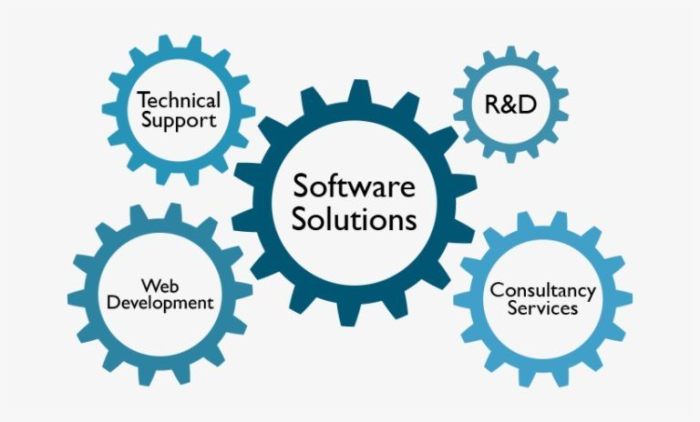In today’s rapidly evolving technological landscape, businesses are constantly seeking efficient and cost-effective ways to develop and maintain their software applications. Nearshore software development has emerged as a powerful solution, offering a compelling alternative to both onshore and offshore outsourcing. This comprehensive guide delves into the intricacies of nearshore software development services, exploring its benefits, challenges, and best practices.
We’ll also address frequently asked questions to provide you with a clear understanding of this increasingly popular approach.
What is Nearshore Software Development?: Nearshore Software Development Service
Nearshore software development refers to outsourcing software development projects to a country geographically closer to your own. Unlike offshore outsourcing, which involves working with teams in distant locations like India or the Philippines, nearshore development typically involves partnering with companies in neighboring countries or regions sharing similar time zones and cultural affinities. This proximity offers several key advantages, as we will explore below.

Source: gagan.law
Benefits of Nearshore Software Development
- Reduced Time Zones Differences: The smaller time zone difference facilitates seamless communication and collaboration, leading to faster project turnaround times and improved responsiveness.
- Improved Communication and Collaboration: Geographical proximity makes it easier to schedule meetings, conduct regular check-ins, and build stronger working relationships with the development team. This fosters better understanding and reduces the risk of miscommunication.
- Cultural Similarity and Language Proficiency: Nearshore partners often share similar cultural values and language, minimizing cultural barriers and simplifying communication. This can lead to smoother project execution and better understanding of requirements.
- Cost Savings: While not as drastically lower as offshore outsourcing, nearshore development still offers significant cost savings compared to onshore development, particularly in terms of labor costs.
- Easier Travel and On-site Visits: The shorter travel distance makes it easier and more cost-effective to visit the development team’s location for on-site meetings, training, or problem-solving.
- Stronger Intellectual Property Protection: Geographical proximity reduces the risk of intellectual property theft, a concern often associated with distant offshore outsourcing.
- Access to Specialized Talent: Nearshore regions often possess a pool of skilled developers specializing in specific technologies or domains, allowing businesses to access specialized expertise without the need for extensive recruitment efforts.
Choosing the Right Nearshore Partner
Selecting the right nearshore software development partner is crucial for project success. Consider these factors:
Key Considerations When Selecting a Nearshore Partner, Nearshore software development service
- Technical Expertise: Assess the partner’s experience and expertise in the relevant technologies and programming languages.
- Project Portfolio: Review their past projects and success stories to gauge their capabilities and experience in handling similar projects.
- Communication and Collaboration: Evaluate their communication style, responsiveness, and willingness to collaborate effectively.
- Development Methodology: Ensure alignment in terms of project management methodologies (Agile, Waterfall, etc.).
- Security and Data Protection: Verify their security protocols and data protection measures to safeguard your intellectual property and sensitive data.
- References and Testimonials: Check references and testimonials from previous clients to assess their reliability and performance.
- Legal and Contractual Agreements: Ensure clear and comprehensive contractual agreements covering intellectual property rights, payment terms, and dispute resolution mechanisms.
Nearshore Development vs. Offshore and Onshore
Understanding the differences between nearshore, offshore, and onshore development is crucial for making an informed decision. Here’s a brief comparison:
| Feature | Nearshore | Offshore | Onshore |
|---|---|---|---|
| Location | Neighboring country or region | Distant country | Same country |
| Time Zone Difference | Minimal | Significant | None |
| Communication | Easy and efficient | Can be challenging | Easy and efficient |
| Cost | Moderate | Lowest | Highest |
| Cultural Differences | Minimal | Significant | None |
Challenges of Nearshore Software Development
While nearshore development offers many advantages, it’s essential to acknowledge potential challenges:
- Language Barriers (though often minimal): Even with similar languages, subtle differences in terminology or slang can sometimes cause misunderstandings.
- Cultural Nuances: While often less significant than with offshore development, cultural differences can still impact communication and collaboration.
- Legal and Regulatory Differences: Differences in legal frameworks and regulations might require careful consideration and adherence.
- Finding the Right Partner: Thorough due diligence is essential to avoid selecting an unreliable or underqualified partner.
Frequently Asked Questions (FAQ)
- Q: What are the best countries for nearshore software development? A: Popular choices include Mexico, Canada (for US companies), and countries in Central and South America, depending on your location and specific needs. The best choice depends on your specific project requirements and priorities.
- Q: How much does nearshore software development cost? A: Costs vary depending on factors such as the complexity of the project, the skill level of the developers, and the location of the development team. Generally, it’s more expensive than offshore but less than onshore.
- Q: What are the key benefits of using a nearshore software development company? A: Key benefits include improved communication, reduced time zone differences, cost savings compared to onshore development, and easier access to skilled developers.
- Q: How can I ensure the security of my intellectual property when using nearshore development? A: Choose a reputable partner with robust security protocols and data protection measures in place. Ensure your contractual agreements clearly define intellectual property rights and responsibilities.
- Q: What are some common pitfalls to avoid when selecting a nearshore partner? A: Avoid partners with poor communication, insufficient experience, or unclear contractual agreements. Always conduct thorough due diligence and check references.
Conclusion
Nearshore software development presents a compelling solution for businesses seeking a balance between cost-effectiveness, efficient communication, and access to skilled developers. By carefully considering the factors discussed in this guide and selecting a reliable partner, businesses can leverage the advantages of nearshore development to achieve their software development goals efficiently and effectively.
References
While specific articles on nearshore development change frequently, a general search on Google Scholar or your preferred search engine using terms like “nearshore software development best practices,” “nearshore software development cost comparison,” or “nearshore software development risks” will yield relevant research papers and articles from reputable sources. Always check the publication date and source credibility before relying on any information.
Call to Action
Ready to explore the benefits of nearshore software development for your next project? Contact us today for a free consultation and let’s discuss how we can help you find the perfect nearshore partner to achieve your goals.
General Inquiries
What are the typical geographical locations for nearshore development?
Common nearshore locations depend on the client’s base, but often include neighboring countries or regions with similar time zones and cultural understanding.
How does nearshore development differ from offshore development?

Source: devtechnosys.com
Nearshore development involves working with teams in geographically closer locations, leading to better communication and collaboration compared to offshore development, which often involves significant time zone differences and cultural barriers.
What are the potential risks of nearshore development?
Potential risks include language barriers (though less significant than with offshore), cultural differences in work styles, and the need for robust communication strategies to mitigate any distance challenges.
How can I find a reputable nearshore software development partner?
Thorough research, checking references, and focusing on partners with proven track records and strong communication capabilities are crucial for finding a reliable nearshore partner.
